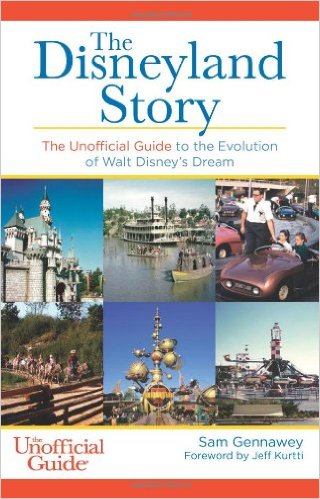As part of coverage of this week’s American Experience: Walt Disney documentary, Bill recommends the 2013 Sam Gennawey book The Disneyland Story as a nice companion to the program.
I have read many biographies about presidents and kings, but never one about a theme park. Yet, that is the easiest way to describe Sam Gennawey’s The Disneyland Story. Disneyland is the inspiration of the modern theme parks of today; it seems appropriate that an entire book be devoted to its creation and growth. I find it surprising that it took this long for a book like this to be written.
The Disneyland Story starts with Walt Disney’s idea and dives into how and why he wanted to build the park. We learn from the beginning that this was not a spur of the moment idea while sitting on a park bench watching his daughters ride a decrepit old merry-go-round — Walt Disney was a storyteller and Disneyland was the continuation of his story telling. He had many inspirations, with the legend of the park bench as just one contributing reason.
Gennawey meticulously references numerous resources to give the reader a thorough play-by-play on the construction of the park and the opening day that was less spectacular and more of a spectacle. As the reader follows Walt around opening the different lands, you see how much was unfinished on opening day, including a Tomorrowland that was neglected until the last minute.
From opening day, we get a year-by-year chronicle of the comings and goings of the park. What amazed me was the rate at which attractions were being added. Only four years after the park opened Walt opened major addition like the Monorail, Matterhorn, and the Submarine Voyage.
We walk through the steps of how attractions are conceived and then changed. The Haunted Mansion started with a walk through museum concept but morphed into the more enjoyable ride through on the doom buggies of today. Pirates of the Caribbean was originally going to be a walk-through wax museum until Walt decided he wanted more, and we now have the high seas boat adventure that it is. Frontierland is known now for the thrills of Big Thunder Mountain, but it use to be about riding pack mules and stagecoaches.
As Disneyland grows, so does Walt’s vision. On opening day, the park’s stores and restaurants were leased out to other business, but by 1959 Walt let the leases lapse on the concessions. He was losing profits and couldn’t guarantee the stores would be open all the time when the park was open. Can you imagine being in a Disney Park and not seeing the stores open? Neither could Walt, which is why he wanted control over all aspects of the park.
The guides on our journey through Disneyland change as the years change. Walt guides us first followed by Imagineering legends John Hench, Marty Sklar, Tony Baxter, and many others. When the 1980s hit, Michael Eisner and Frank Wells have their impact on the park, which is explained in the book. We even get to see the expansion of the Disneyland Resort and the addition of Disney California Adventure.
You also get to read about the attractions that were never built, like Edison Square where you could see how Thomas Edison had made such a dramatic impact on the development of America. WESTCOT, the first idea for a second gate at Disneyland that would have been a west coast version of Epcot, is discussed as well. We also get to see the development and death of Port Disney, another theme park that would have been built in Long Beach, California. The designs for this canceled project heavily influenced Tokyo Disney Sea.
One proposed land that seemed very interesting to me was Discovery Bay. Planned to match up with the release of the 1974 Disney movie The Island at the Top of the World, Discovery Bay would have been a new land attached to Frontierland where the age of Victorian invention would have been proudly displayed with the backdrop of stories from Jules Verne. The movie bombed at the box office, and the Imagineers’ ideas were scrapped.
The Disneyland Story goes into great detail about the relationship and influence that the park has had on the city of Anaheim. From concept to building and everything in between, this well-written book by Sam Gennawey will not disappoint a Disney Parks fan.

